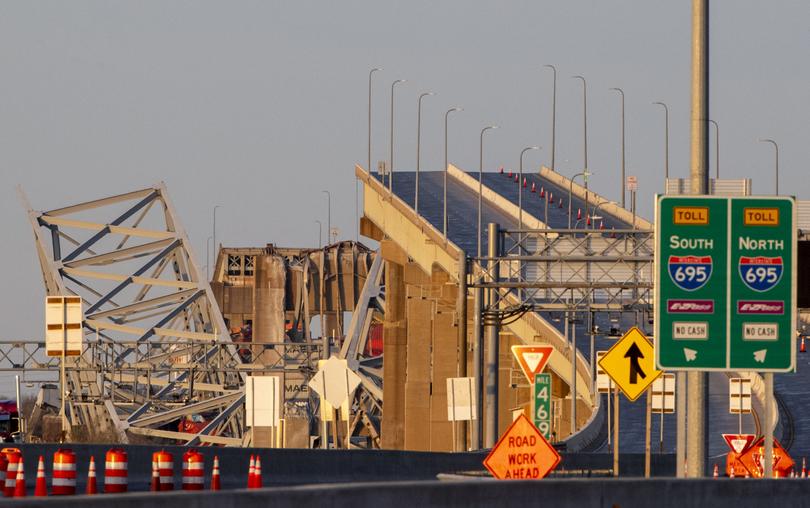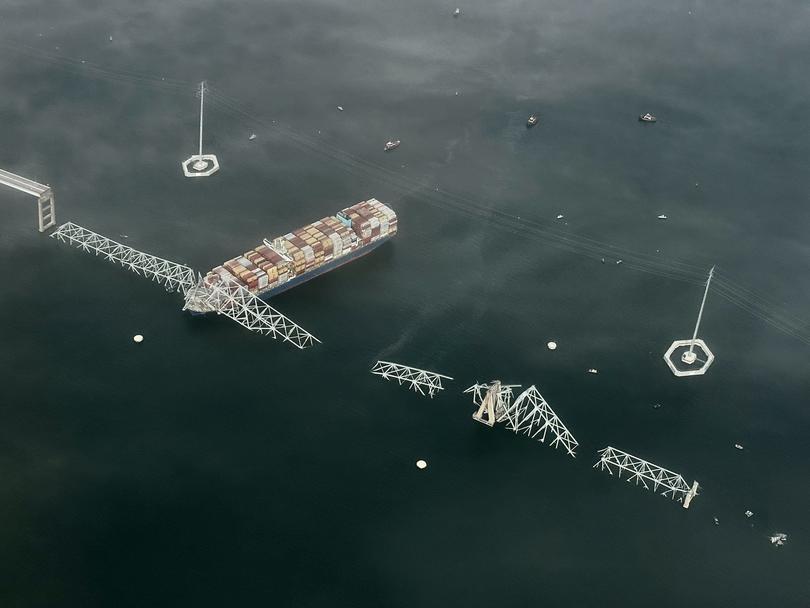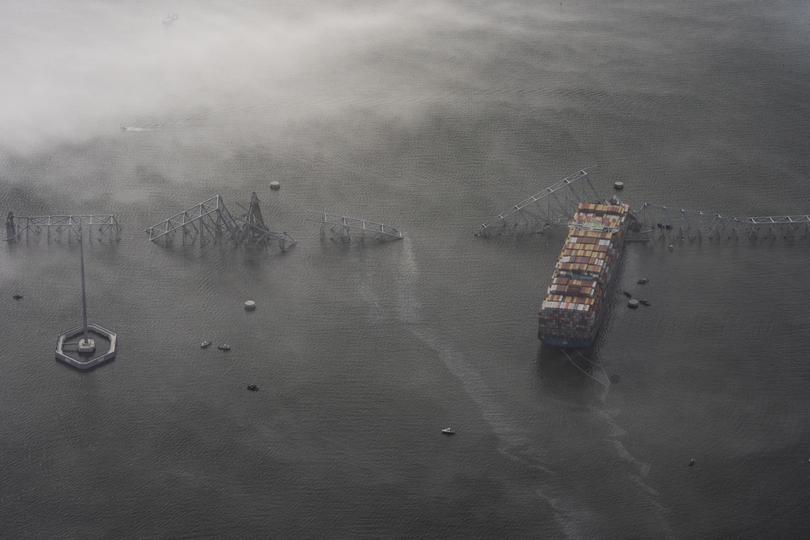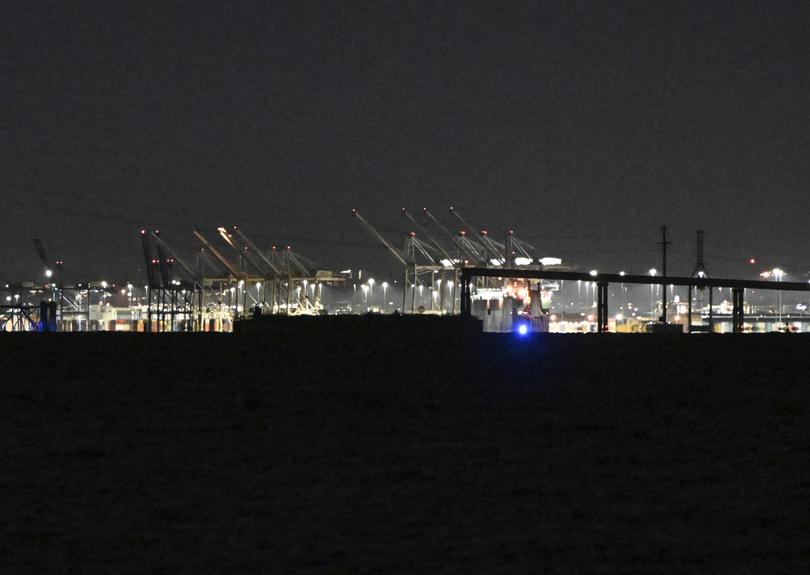Francis Scott Key Bridge collapse: Ship lost power before crashing into bridge; 6 still missing
A major bridge in Baltimore collapsed after being hit by a freighter at about 1:30 a.m. Tuesday, sending at least eight people from a construction crew into the water as a large section of the bridge crashed into the Patapsco River.
The container ship, traveling at a relatively rapid speed of about eight knots, lost power in the moments before it struck the bridge, Maryland Gov. Wes Moore (D) said at a news conference.
Moore said a preliminary investigation indicates “an accident” and that there is no evidence of a terrorist attack.
Sign up to The Nightly's newsletters.
Get the first look at the digital newspaper, curated daily stories and breaking headlines delivered to your inbox.
By continuing you agree to our Terms and Privacy Policy.The governor declared a state of emergency and said he was working with federal agencies to deploy resources for the response. Baltimore Mayor Brandon Scott (D) announced that the city has deployed its emergency operations plan.
Maryland Transportation Secretary Paul J. Wiedefeld said a construction crew was on the bridge at the time it collapsed. The workers were repairing potholes and masonry. Wiedenfeld said officials believe that eight members of that crew fell into the water. Two have been rescued.
At a news conference around 10am, officials said that at least eight people were victims of the collapse.
Wiedefeld said that one person declined treatment at the scene, one person was hospitalised, and six people were unaccounted for.
Officials believe that those six were working on the bridge repairing masonry and potholes at the time of the collapse, according to Wiedefeld.

Maryland Gov. Wes Moore (D) said at the conference that the bridge was “fully up to code.” Authorities responded to the scene after the crew of the vessel that struck the bridge alerted officials to a power problem, according to Moore. There was “no credible evidence” that terrorism was involved, the governor said.
“We had officials that were able to begin to stop the flow of traffic so that more cars were not on the bridge,” he said. “Many of the vehicles were stopped before they got on the bridge, which saved lives.”
Officials declined to say when the 1.6-mile bridge would be repaired or how much the repairs would cost.
President Biden said at a midafternoon address that the federal government will pay for the cost to rebuild the crumpled bridge and called on Congress to support his plans. The key priority is search and rescue, Biden said, but he said officials will work to rebuild and reopen the Baltimore port “as soon as humanly possible.” He said 15,000 jobs depend on the port.
Police radio traffic recorded at 1:27 a.m. captures responders rushing to evacuate and hold traffic on the bridge after an officer announced that a ship had lost control of its steering, according to records from Broadcastify, an open-source audio streaming service.
“Hold all traffic on the Key Bridge,” someone says. “There’s a ship approaching that just lost their steering.”

Others announce they are en route to the bridge or already holding traffic. One asks whether there are workers on the bridge and whether anyone can contact the “foreman to see if we can get them off the bridge temporarily.”
About a minute after the original message reporting a loss of steering, someone shouts, “The whole bridge just fell down!”
Wiedefeld said around 35,000 people per day used the bridge, which spanned the Patapsco River from Baltimore’s Inner Harbor. A “nonunion concrete crew” for the contractor Brawner Builders Inc. was on the bridge when it collapsed, according to Greg Akerman, president of the Baltimore-DC Building Trades Union.
On Tuesday, Bridge worker Jesus Campos, who works for Brawner Builders, paced in a Royal Farms store parking lot near Fort Armistead Park, anxiously awaiting word about the fate of six of colleagues.
Campos said his company had been tasked with fixing potholes on the bridge. He was not working Monday night but was rustled out of bed about 5 a.m. Tuesday by another colleague. The co-worker told him two people had been rescued from the water but that six others - all Latino men - were missing.
Campos, who speaks only Spanish, said all eight men had been on a meal break sitting in or near their vehicles when the bridge collapsed.
“I’m very sad right now,” Campos said. “These are my co-workers and friends.”

Campos said working on the bridge is harrowing. Construction crews are continually worried about speeding motorists, and the bridge “moves a lot” due to its design and engineering.
But Campos said he never imagined that the structure would collapse. He also downplayed the overall dangers of his job.
“If you were scared, you probably wouldn’t have taken the job in the first place,” he said.
Brawners Builders, based in Cockeysville, Md., describes itself on its website as a “full service general contractor” that specializes “in Bridge Access Equipment, Bridge Inspection Units, Underbridge Bucket and Platform Equipment, and Hi-Rail Equipment Rentals.”
A woman who answered the phone at the company Tuesday declined to comment but took a message for senior management.
Maryland Gov. Moore said the Dali lost power and issued an emergency call for help shortly before the freighter crashed into the bridge.
The “mayday” distress call allowed officials to halt vehicle traffic headed over the bridge, Moore (D) said.
“By being able to stop cars from coming over the bridge, these people are heroes. They saved lives,” he said.

It was not immediately clear how many vehicles were on the bridge at the time of the collapse. Search and rescue efforts continue.
Moore said at a news conference that the cargo ship was headed at the bridge at eight knots, which he called “a very, very rapid speed.”
The Apostleship of the Sea in Baltimore, a Catholic ministry that provides services for seafarers when they arrive at the port, welcomed the captain and crew of the Dali when the cargo ship docked on Saturday.
Andrew Middleton, director of the ministry, said he and his team took the crew shopping and to check out books at a local library. Employees transport crew members to local establishments and provide counseling to those on board, who are often far from home and dealing with the strains of life at sea.
Middleton said as soon as he heard on the radio that the Dali had crashed into the Key Bridge early Tuesday, he texted a crew member early Tuesday.
“Is everyone on board safe?” he messaged at 6:03 a.m.
Five minutes later, the crew member replied.
“Yes,” he said. “By God’s grace.”

Baltimore Fire Chief James Wallace said in an interview Tuesday morning on CNN that sonar has revealed five vehicles on the bed of the Patapsco River. He said they include three passenger vehicles, a cement truck and one unknown vehicle. It’s unclear if anyone is inside those vehicles.
Within hours of the Francis Scott Key bridge collapse in Maryland, verified accounts on Elon Musk’s X social media platform began spreading conspiracy theories about the event.
Maryland officials reiterated several times during a morning news conference that there is no credible evidence linking the disaster to terrorism.
Many of the accounts posting about conspiracies engage in what’s called “engagement farming,” where they attempt to post the most outrageous or extreme beliefs or theories about an event in an effort to generate attention, which they can then monetize. Verified accounts on X can receive payments of thousands of dollars for posting things that are heavily reshared and replied to.
One account posting under the name Paul A. Szypula, with over 137,200 followers, posted that Synergy Marine Group, the company that managed the ship that collided with the bridge, promoted diversity, equity, and inclusion (DEI) in their company. “Did anti-white business practices cause this disaster?” he posted. “Did DEI cause this collapse?” he asked in another tweet.
Several verified accounts on X blamed the Jewish people for the bridge collapse and suggested the state of Israel had something to do with it.
Still unclear is the status of cruises leaving from Baltimore, where three cruise lines operate. No ships were in port Tuesday morning. The next cruise is scheduled to depart Sunday; no information is available yet on how that will be affected.
Amira M. Hairston, a spokeswoman for the port, said in an email that the status of the upcoming cruise ship schedule is not yet known. Vessel traffic into and out of the Port of Baltimore has been suspended until further notice.
Royal Caribbean International’s Vision of the Seas left Saturday for a 12-night southern Caribbean cruise with plans to return April 4. The cruise line said in a statement that it was “closely monitoring the situation, and our port logistics team is currently working on alternatives for Vision of the Seas’ ongoing and upcoming sailings.”
Royal Caribbean International will contact guests and travel partners once plans are final, the operator said.
Carnival Legend set off Sunday for a seven-day Bahamas cruise; the ship is scheduled to return March 31 and depart for its next sailing the same day. Carnival Pride is scheduled to start sailing from Baltimore next month, mostly to the Bahamas and eastern Caribbean.
Carnival Cruise Line spokesman Matt Lupoli said in an email that it was “premature for us to comment on possible impacts to upcoming sailings” and directed questions to the Cruise Lines International Association.
Norwegian Cruise Line does not have cruises scheduled out of the port until later this year.
The industry association said it was “deeply saddened” by the bridge collapse and was closely following the situation.
“Right now, the most important thing to do is to allow the emergency workers to do their work,” the group wrote in a statement.
This year, 12 ships are scheduled to make a total of 115 calls at the Port of Baltimore, the industry association said, representing 378,000 passenger movements.
“Any adjustments to current cruise activity at the port will be announced as soon as available by the individual cruise lines,” CLIA said in its statement.
A press release issued by the governor’s office says more than 444,000 people cruised out of the Port of Baltimore last year, the highest number since 2012. The Maryland Port Administration said in a news release last year that the cruise industry generates nearly 400 jobs and $63 million in revenue every year for local businesses.
Baltimore’s Francis Scott Key Bridge had the third-longest main span among all continuous truss bridges in the world. It measured over 1,200 feet between adjacent towers and supporting pillars. The longest bridge of this kind is in Japan and it spans just over 1,300 feet.
Jim Fischer, 73, helped build the structure in 1974. A construction worker, he recalled being ferried out in the Patapsco River in a tugboat. He was then dropped off onto a pylon to pour concrete into the structure.
“And that was solid concrete,” Fischer said. He added that the main support beams of the bridge were protected by “dolphins” - truck-sized barriers that he thought would have withstood the impact from a cargo freighter. About a decade ago, Fischer said, several people on a recreational boat were killed after the boat collided with a dolphin.
“I never thought in a million years anything like this could happen,” he said. “And what was incredible to me, is how fast it came down. It really is just unbelievable.”
The White House is “closely monitoring” the developments at the bridge and so far has seen “no indication of any nefarious intent,” according to a White House official who spoke on the condition of anonymity to discuss internal deliberations.
Singapore’s Maritime Port Authority said Tuesday evening local time that it was investigating the collision and providing “full cooperation” to the U.S. Coast Guard. The authority, which regulates marine services in Singapore, confirmed that a Singapore-registered vessel struck the Francis Scott Key Bridge around 1:30 a.m. Eastern time. There were 22 crew members on board during the collision, it said.
“MPA is in contact with the U.S. Coast Guard and the ship management company to provide the necessary assistance,” said the authority.
The cargo ship, Dali, is about 48 meters (157 feet) wide and 300 meters (984 feet) long and was built in 2015, according to MarineTraffic.com.
The vessel was en route to Colombo, Sri Lanka, according to Vessel Finder, which live tracks global shipping, and had been due to arrive on April 22. Before Baltimore, it had called at ports in Norfolk and New York in the United States and before that the Panama Canal.
The registered owner of the ship is Grace Ocean Pte Ltd., and it is managed by Synergy Marine Group. Neither immediately responded to a request for comment from The Washington Post. However, an official from Grace Ocean told global shipping news site TradeWinds that the vessel was under the bridge at the time and that the company is “working with the ship’s technical manager Synergy Marine to determine what happened.”
“Whilst the exact cause of the incident is yet to be determined, the Dali has now mobilized its qualified individual incident response service,” Synergy Marine Group said in a statement to Reuters, adding that all crew members, including the two pilots who were aboard, have been accounted for and that there are no reports of any injuries among the crew.
Transportation Secretary Pete Buttigieg said he spoke with the governor of Maryland and Baltimore’s mayor early Tuesday to offer the department’s help in responding to the vessel strike and bridge collapse. “Rescue efforts remain underway and drivers in the Baltimore area should follow local responder guidance on detours and response,” Buttigieg added.
It was not immediately clear how the bridge collapse would affect access to the Port of Baltimore, one of the nation’s largest shipping hubs and a driver of the region’s economy.
The port annually generates nearly $3.3 billion in total personal income, $2.6 billion in business income and more than $395 million in taxes, according to a Maryland state website. It handled 52.3 million tons of international cargo last year, which was valued at $80.8 billion.
© 2024 , The Washington Post
